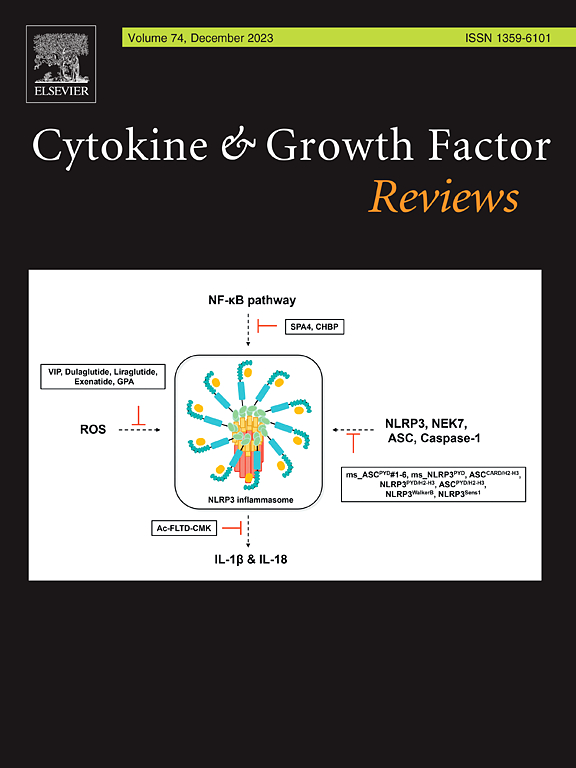从衰老到瘢痕形成:探索TGF-β信号在细胞衰老、纤维化重塑和肺纤维化中的作用。
IF 11.8
2区 医学
Q1 BIOCHEMISTRY & MOLECULAR BIOLOGY
引用次数: 0
摘要
细胞衰老和纤维化瘢痕的形成在慢性疾病的进展中至关重要,如肺纤维化(PF)。在这种情况下,转化生长因子-β (TGF-β)途径是协调病理级联的核心驱动因素。TGF-β作为一种多效细胞因子调控细胞活动,如分化、凋亡和细胞外基质(ECM)重塑。在肺部,TGF-β信号失调导致细胞衰老和促炎介质的释放,构成衰老相关分泌表型(senescence associated secretory phenotype, SASP)。这加强了有利于成纤维细胞激活的微环境,延长了肌成纤维细胞的保留,加速了异常的ECM沉积,最终导致进行性组织纤维化。例如,特发性肺纤维化(IPF)的特征是衰老肺泡上皮细胞(AECs)的积累,这些细胞损害正常的组织修复并改变微环境以促进纤维生成。TGF-β信号通过smad依赖(典型)和smad独立(非典型)途径被激活,每种途径都有助于激活成纤维细胞的持久性,异常ECM积累和不可逆的组织重塑。衰老和TGF-β信号之间的相互依赖使纤维化损伤永久化,并增加对未来纤维化损伤的易感性。这篇综述深入了解TGF-β信号和PF细胞衰老的分子趋同,重点介绍了关键的生物标志物和新兴的治疗策略。虽然一些评估TGF-β拮抗剂、小分子和基于细胞的疗法的临床试验显示出相当大的希望,但它们能否成功转化为有效的靶向治疗仍然存在挑战。然而,继续探索TGF-β在纤维化和衰老中的多方面作用为开发PF和其他慢性纤维化疾病的创新疗法提供了希望。本文章由计算机程序翻译,如有差异,请以英文原文为准。
From senescence to scarring: Exploring TGF-β signaling in cellular aging, fibrotic remodeling, and pulmonary fibrosis
Cellular senescence and the formation of fibrotic scarring are critical in the progression of chronic illnesses, such as pulmonary fibrosis (PF). In this context, the transforming growth factor-beta (TGF-β) pathway represents a central driver in orchestrating the pathological cascade. TGF-β governs cellular activities such as differentiation, apoptosis, and extracellular matrix (ECM) remodeling as a pleiotropic cytokine. In the lungs, dysregulated TGF-β signaling leads to cellular senescence and release of pro-inflammatory mediators, constituting the senescence-associated secretory phenotype (SASP). This reinforces a microenvironment conducive to fibroblast activation, prolonged myofibroblast retention, and accelerated aberrant ECM deposition, culminating in progressive tissue fibrosis. For instance, idiopathic pulmonary fibrosis (IPF) is marked by the buildup of senescent alveolar epithelial cells (AECs) that impair regular tissue repair and alter the microenvironment to promote fibrogenesis. TGF-β signaling is activated through SMAD-dependent (canonical) and SMAD-independent (non-canonical) pathways, each contributing to the persistence of activated fibroblasts, aberrant ECM accumulation, and irreversible tissue remodeling. The interdependence between senescence and TGF-β signaling perpetuates fibrotic injury and enhances susceptibility to future fibrotic insults. This review delves into understanding the molecular convergence of TGF-β signaling and cellular senescence in PF, highlighting key biomarkers and emerging therapeutic strategies. While several clinical trials evaluating TGF-β antagonists, small molecules, and cell-based therapies show considerable promise, challenges remain regarding their successful translation into effective, targeted treatments. Nevertheless, continued exploration of TGF-β’s multifaceted role in fibrosis and senescence offers hope for developing innovative therapies for PF and other chronic fibrotic diseases.
求助全文
通过发布文献求助,成功后即可免费获取论文全文。
去求助
来源期刊

Cytokine & Growth Factor Reviews
生物-生化与分子生物学
CiteScore
21.10
自引率
1.50%
发文量
61
审稿时长
22 days
期刊介绍:
Cytokine & Growth Factor Reviews is a leading publication that focuses on the dynamic fields of growth factor and cytokine research. Our journal offers a platform for authors to disseminate thought-provoking articles such as critical reviews, state-of-the-art reviews, letters to the editor, and meeting reviews.
We aim to cover important breakthroughs in these rapidly evolving areas, providing valuable insights into the multidisciplinary significance of cytokines and growth factors. Our journal spans various domains including signal transduction, cell growth and differentiation, embryonic development, immunology, tumorigenesis, and clinical medicine.
By publishing cutting-edge research and analysis, we aim to influence the way researchers and experts perceive and understand growth factors and cytokines. We encourage novel expressions of ideas and innovative approaches to organizing content, fostering a stimulating environment for knowledge exchange and scientific advancement.
 求助内容:
求助内容: 应助结果提醒方式:
应助结果提醒方式:


